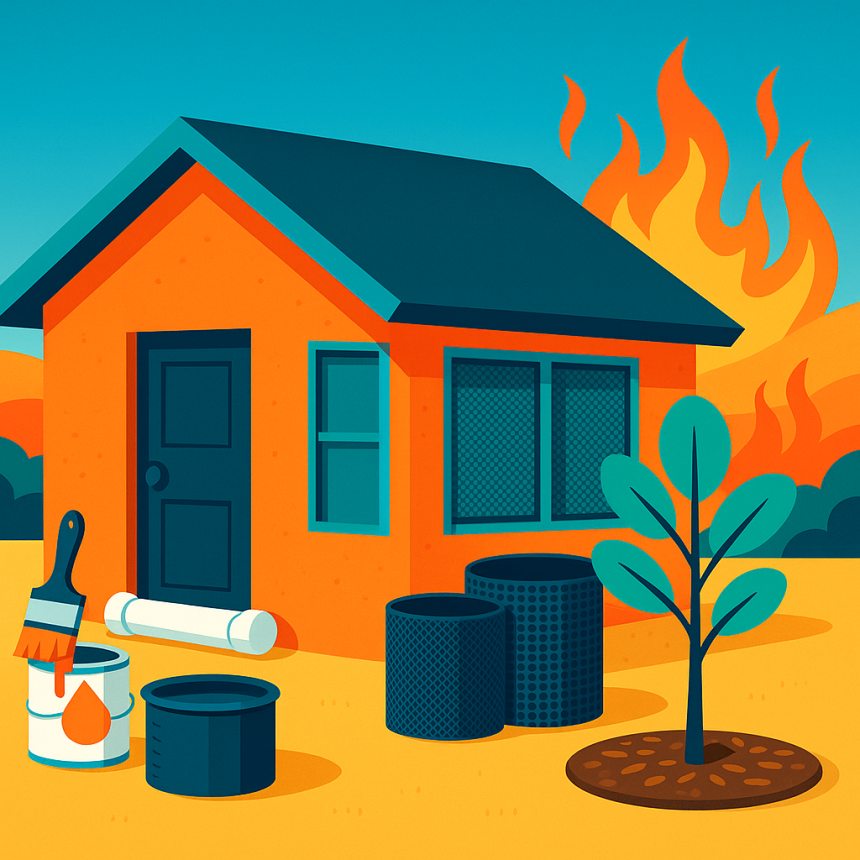Bushfire Protection Australia – Home Upgrades
Have you ever stood outside on a scorching afternoon, smoke haze drifting in, and wondered—“Is my home really ready if a fire comes close?” Maybe you’re in suburbia, maybe you’re on acreage, or maybe you’re a firefighter who’s seen what wind-blown embers can do in minutes. Either way, you know it’s not just the big, expensive stuff that makes the difference. It’s the practical, affordable upgrades and the small things done right.
In this guide, you’ll find simple, proven ways to boost your home’s bushfire protection—without breaking the bank or needing a trades ticket. We’ll cover easy ember-proofing, clever use of fire-retardant paints, choosing the right mesh screens, smart landscaping, and more. Whether you’re renting, renovating, or just starting out, these steps will help you and your family feel safer, calmer, and better prepared—no matter where you live or how much you know about fire.
For those on the frontline, you’ll find tips for quick crew checks and logistics too—because what works for homes often helps protect sheds, trucks, and staging areas. And throughout, we’ll share lessons learned the hard way—so you don’t have to repeat them.
Campboss Modular First Aid Kit for emergencies
—because when something goes wrong, you want the right tools close at hand.
Why Upgrade Your Home for Bushfire?
Let’s be honest—most homes in Australia weren’t built with bushfires in mind. Many older houses, sheds, and even newer builds have gaps where embers can sneak in, gardens that grow wild near windows, and timber decks that could catch alight before you even know there’s trouble. For renters, you might feel powerless, but the truth is, there are plenty of things you can do, with or without a landlord’s help.
Upgrading for bushfire doesn’t mean spending a fortune. It’s about the little wins that stack up: blocking the tiny gaps, clearing flammable clutter, using the right paint or mesh, and making smarter choices in the garden. These actions are proven to buy you time—and sometimes, that’s all you need for your family, your team, or your crew to get to safety.
Ember-Proofing: The Small Gaps That Matter Most
Embers are the silent danger in most bushfires. They can drift for kilometres, finding their way through the smallest cracks—roof gaps, under doors, through vents. More homes are lost to ember attack than direct flames. For firefighters, it’s a scene we know all too well: a house standing untouched by fire, but smoke pouring from the roof where an ember got in.
Here’s what works—at home and on the fireground:
- Seal gaps under doors with weather strips (simple stick-on foam does the job)
- Fit metal mesh (1.8mm or finer) over vents, weep holes, and under-eave gaps
- Use draft stoppers inside, especially on external doors during fire season
- Block any visible gaps in your roof, walls, or around windows with fire-resistant sealant or steel wool
- On sheds, trucks, or staging areas, tape over open louvres and gaps with aluminium tape before a hot day
If you’re renting, focus on temporary fixes—draft stoppers, removable mesh, rolled-up towels. For crews, make ember checks part of your “last lap” around assets before pulling back.
Fire-Retardant Paints and Coatings: Extra Protection for Less
Not everyone can afford a brand new “fire-proof” build. But for the price of a few tins of paint, you can add a valuable extra layer of protection to timber decking, fencing, or eaves. Fire-retardant paints slow down ignition and give you precious extra minutes, which can be the difference between minor damage and a total loss.
Where to use fire-retardant coatings:
- Timber decks, balustrades, handrails, and steps (especially if you have trees or garden beds close by)
- External timber window frames and doors
- Timber sheds or garden boxes near the house
- Fences along property boundaries
Application is usually as simple as a standard paint job—just check for “AS 1530.8.1 compliant” products for bushfire zones. For fire crews, a can of spray-on retardant or even a mop and bucket can be a handy asset on the fireground, especially for protecting staging areas or vulnerable outbuildings.
Mesh Screens: Stop Embers, Save Homes
When you watch ember showers hit a home, you realise how easy it is for sparks to find a way in. Fine steel or bronze mesh (1.8mm or less) makes a huge difference—fitted over windows, doors, vents, and even gutters. In many cases, it’s a simple DIY fix with a few basic tools.
Mesh screen basics:
- Choose stainless steel or bronze for longest life (avoid plastic—heat melts it!)
- Fit screens snugly, with no gaps along the edges
- Don’t forget skylights, whirlybirds, or roof vents—use offcuts or buy mesh covers
- Clean gutters first, then fit mesh guards to stop leaf build-up and ember entry
- For crews, mesh sheets can protect pump intakes or be taped over vents on vehicles during hot runs
Even a single unscreened window can undo all your other hard work. If you’re renting, ask about mesh as a temporary upgrade—it often pays off at inspection time too.
Landscaping for Fire Resistance: Beauty and Safety
Your garden can help protect your home—or put it at risk. Keeping it tidy, well-watered, and thoughtfully laid out is one of the best bushfire defences (and it doesn’t have to mean giving up all your plants or spending a fortune).
Practical landscaping tips:
- Keep lawns short and green in fire season—water if you can
- Prune back shrubs, tree limbs, and ground covers that grow near windows, decks, or walls
- Use gravel, pavers, or stone as mulch close to the house (avoid bark or woodchip right against the walls)
- Plant low-flammability species (succulents, native groundcovers) near entryways
- Store firewood, gas bottles, and garden clutter away from the house—at least 10 metres if possible
For renters, even shifting pot plants and clearing leaves from around doors can make a real difference. On the fireground, keeping “defendable space” clear around tanks, pumps, and assembly points is standard crew practice for a reason—it works.
Other Practical Upgrades That Add Up
Mistakes to Avoid (and What Firefighters Notice)
- Don’t leave doormats, shoes, or garden hoses on timber decks—they’re tinder in waiting.
- Avoid storing cardboard boxes, plastic furniture, or bins under eaves or next to walls in summer.
- Don’t forget to clear out gutters—just one season’s leaves can light up the roofline.
- Never rely on just one strategy (e.g. mesh but no yard cleanup, or vice versa)—layering is key.
- Crews: Always double-check around vehicles, command posts, and crew quarters for “ember traps” before moving out.
Special Considerations for Renters and Vulnerable People
If you’re renting or can’t tackle big projects, focus on low-cost, moveable options. Draft stoppers, clip-on mesh screens, and portable fire-retardant mats all help. Always ask your landlord about more permanent upgrades—many will say yes if you offer to share the cost or do the work yourself.
For people who are elderly, living alone, or managing a disability, involve friends, family, or carers in your bushfire plan. Don’t be afraid to ask for help with bigger jobs. Your safety matters—and small changes still count.
For Firefighters and Emergency Services: Crew & Asset Protection
If you’re part of a crew or leading volunteers, many of these “home” upgrades work just as well for sheds, staging areas, and vehicles. It’s the same principle: block ember entry, keep surrounds clear, check mesh on windows/vents, and make a “last lap” routine before leaving.
Crew checklist:
- Pack spare draft stoppers, mesh sheets, and rolls of aluminium tape in the truck
- Assign a “last lap” duty—one person does a full check around all assets before relocating
- Keep “ember buckets” or mops handy for dousing spot fires in and around assets
- Train all team members on what to look for: small gaps, garden clutter, stored fuel, etc.
- Share lessons from past jobs and let rookies learn from old hands—it saves mistakes
If you’ve found a trick that works—share it. One clever fix can make the difference for the next crew, or the next house you defend.
Planning Ahead: What To Do Next
Upgrading your home for bushfire protection doesn’t have to be overwhelming. Start with one room, one door, or one garden bed. Do what you can each month—before fire season ramps up. Involve the family, your housemates, or your crew. Share jobs and learn together.
Keep a running “to-do” list, tick off small wins, and remember: every improvement counts. If you’re not sure what matters most, ask your local emergency service or check government bushfire safety advice.
FAQs: Your Bushfire Home Upgrades Questions Answered
Q: Can I do bushfire upgrades if I’m renting?
Absolutely. Use temporary mesh, draft stoppers, and focus on clearing clutter. Ask your landlord about permanent upgrades—they often help with costs. Even small, moveable fixes make a big difference.
Q: Do mesh screens really help during bushfires?
Yes! Fine steel mesh stops embers from getting in and saves homes from catching alight. The tighter the fit, the better. Many homes survive thanks to well-fitted mesh alone.
Q: What’s the cheapest upgrade with the biggest impact?
Blocking gaps under doors and fitting mesh over vents are both low-cost but powerful. Even a rolled-up towel or stick-on foam works in a pinch.
Q: I have pets/elderly at home. Any special advice?
Pack a go-bag with essentials for everyone, including leads, food, medication, and contact numbers. Have a plan for safe transport. Practise your routine before fire season starts.
Q: For crews—what’s one fireground tip for asset protection?
Assign a “last lap” check around all vehicles, sheds, and gear. Block gaps, clear combustibles, and always carry mesh, tape, and a bucket. What works at home works in the field too.
Q: Do I need to hire a professional for these upgrades?
Not always! Most fixes can be DIY with basic tools. For complex jobs (roofing, electrical), use a licensed tradie. Ask your local service for advice if unsure.
Take a step today:
Choose one upgrade from this list and tackle it this week. Then share what you’ve learned with your family, friends, or crew. Every action makes your home—and your community—safer.



